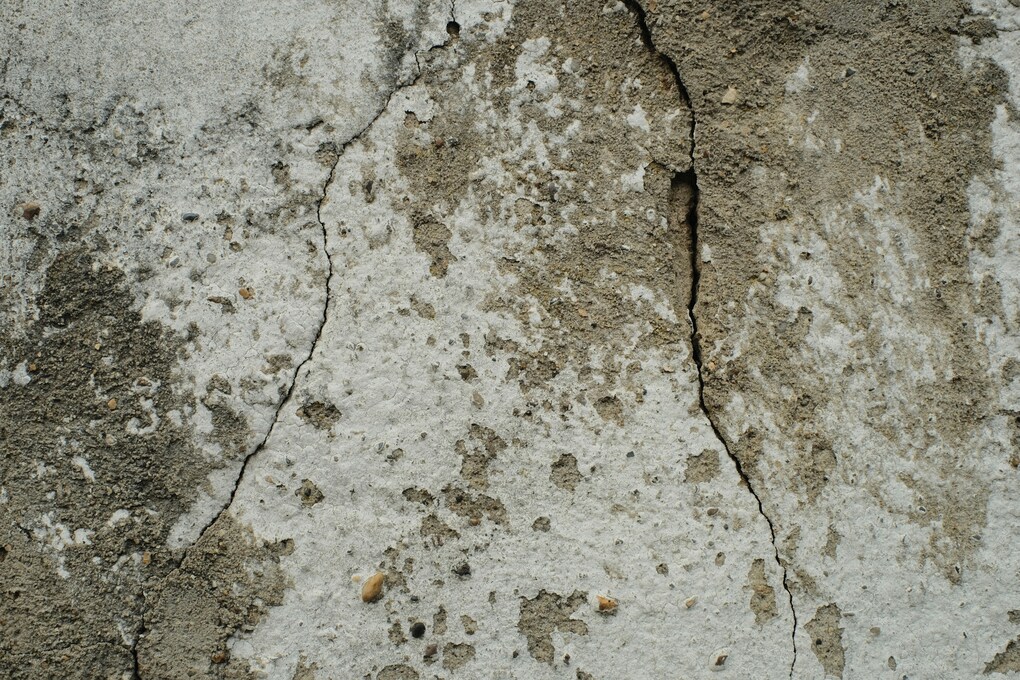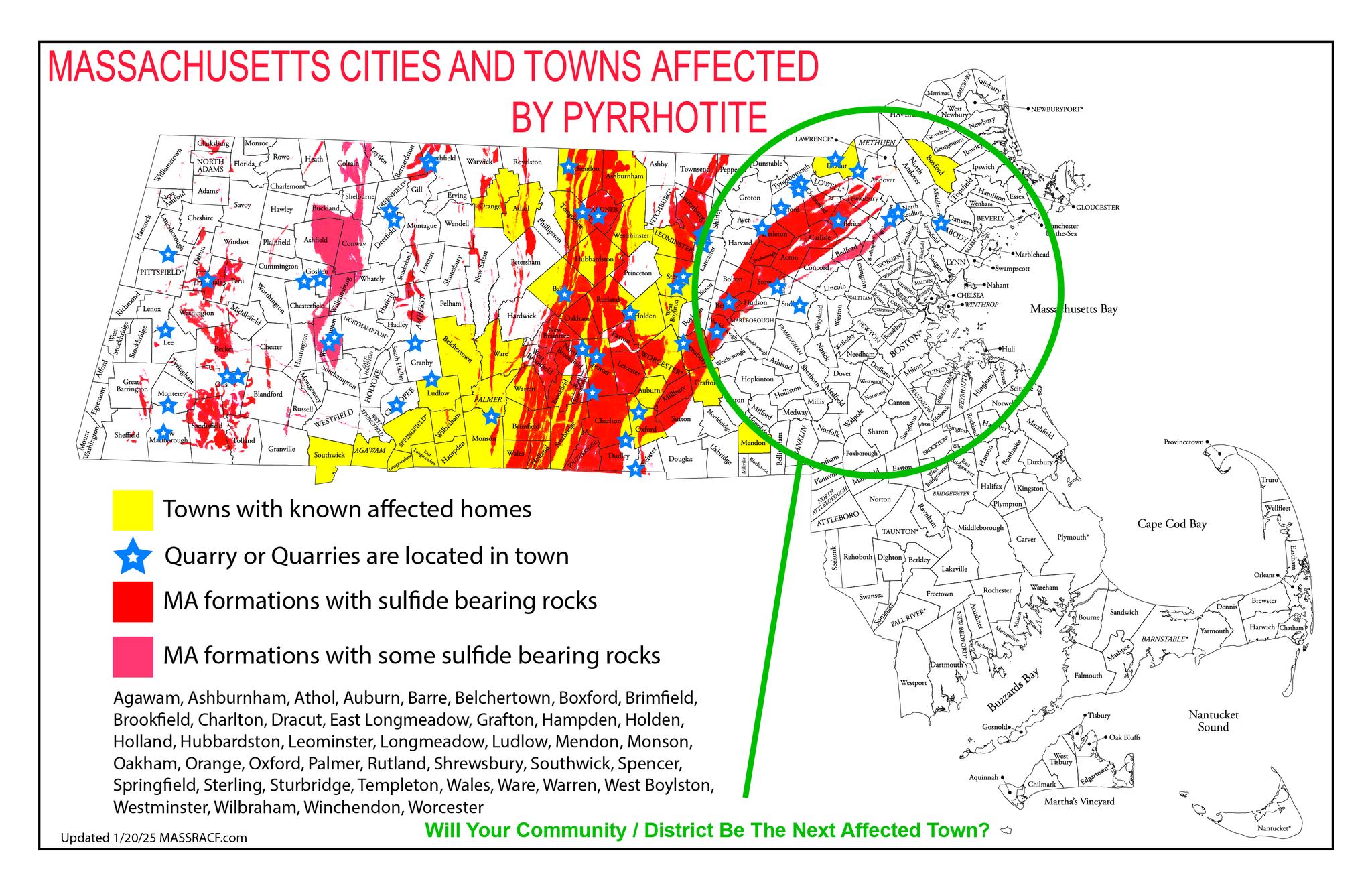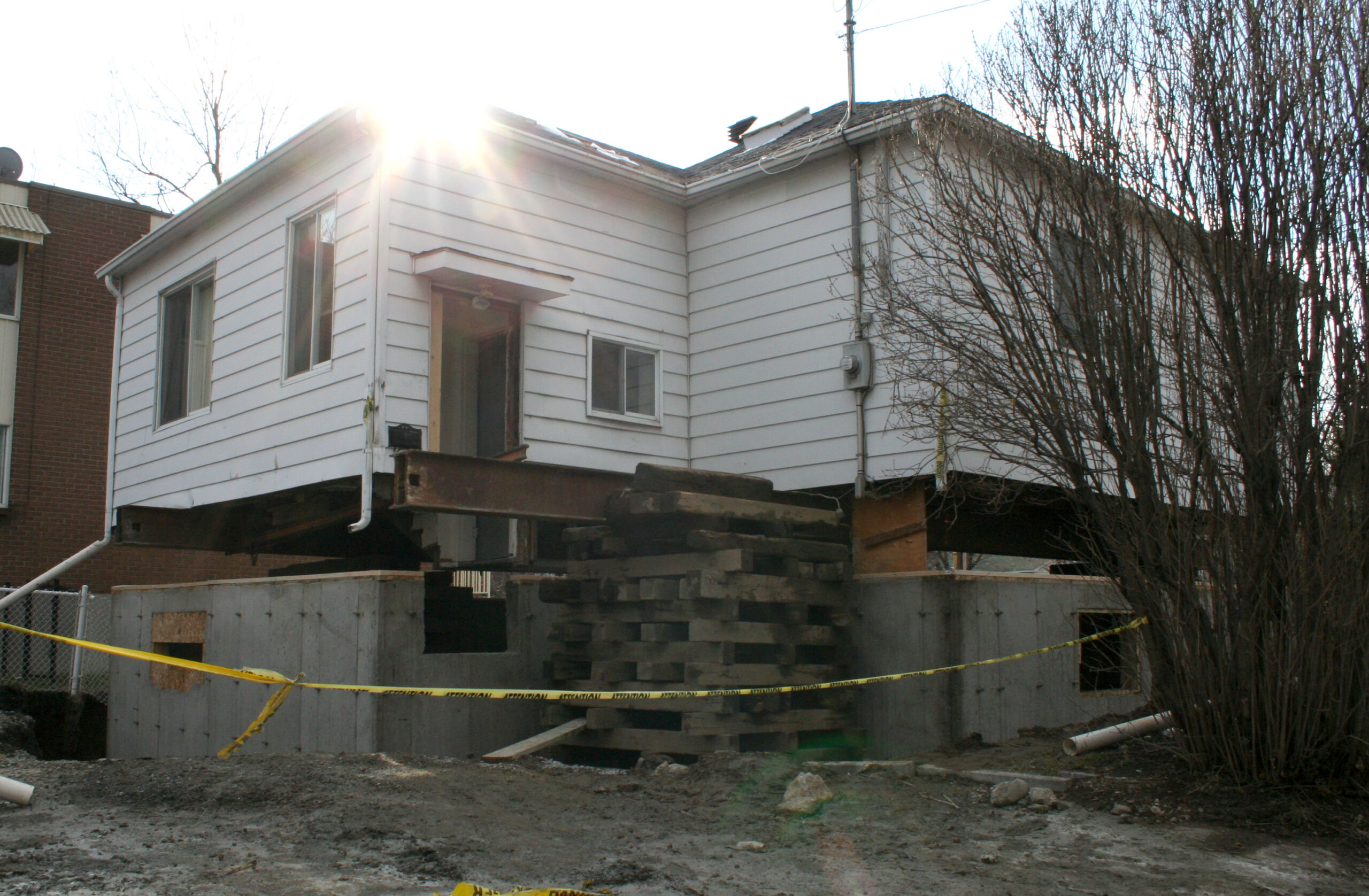Crumbling Foundations: The Architectural Nightmare Creeping Through Massachusetts
. Posted in News - 0 Comments
By Kimberly Rau, MassLandlords, Inc.
Some homeowners in Massachusetts with poured concrete foundations are experiencing serious, expensive issues as they learn their foundations were poured with a stone mixture that contains pyrrhotite. This mineral, which expands when it comes in contact with water and air, causes such serious foundation damage the only solution is full replacement.

If the cracks in your foundation are from pyrrhotite, then by the time you see them on exterior walls, there’s already significant damage. (Image: Rhubbardstockfootage for Unsplash)
Once thought to be an issue contained in Connecticut, pyrrhotite is revealing itself to be enough of a problem in Massachusetts that advocate groups are pushing for relief from the state.
Background: What Is Pyrrhotite and Why Is it Bad For Foundations?
Pyrrhotite is a naturally occurring mineral in New England, but it should never be in a concrete stone mixture, because it is very damaging to home foundations.
When pyrrhotite ends up in the stone mix for concrete, it means trouble for homeowners. When exposed to air and moisture, pyrrhotite tends to rust and expand, leading to cracks in the foundation. This can happen very slowly in a concrete foundation, often over two or three decades. By the time homeowners notice cracking on the outer walls, chances are the damage inside the foundation is extensive.
If left alone, the foundation will continue to deteriorate, throwing the whole house off balance. Drywall can crack, doors and windows may no longer open, and in the worst cases the house itself may be pushed off the foundation.
There is no way to “fix” a foundation with pyrrhotite damage. The entire thing must be replaced, a costly and time-consuming endeavor that involves raising the house up off its foundation so the damaged one can be removed and a new foundation can be poured. This can take weeks or months depending on the size of the home. Average replacement costs can range from $150,000 to $250,000, and homeowner’s insurance will not cover it.
Signs of pyrrhotite include map- or spiderweb-like cracks in the foundation. These can be hard to see at first, especially if you have a finished basement where drywall may cover the foundation. You may also suddenly notice your floors are uneven, or your windows or doors are “sticking.” A professional home inspection can confirm warning signs, but only a core test can confirm pyrrhotite’s presence for sure.
A core test is when an expert drills into the foundation, taking cylindrical samples of the concrete. These samples are sent to a lab, which tests them to determine if pyrrhotite is present. This can be very expensive (sometimes as much as several thousand dollars), and it may take several weeks before results are returned.

Becker’s Quarry in Connecticut
In the 1980s, the J.J. Mottes Concrete Company started mining in Becker’s Quarry in Willington, Conn. While blasting, pyrrhotite in the bedrock accidentally became part of the stone mix intended for concrete. This mining took place from 1983 to 2014, at which point an agreement was reached to stop using the quarry’s aggregates in concrete. Many Connecticut homes with poured concrete foundations built during this time were impacted. Stone from this quarry is no longer used in home foundations, but because damage can take 10 or more years to become apparent, homeowners are still finding problems today.
In 2020, the federal Government Accountability Office reported 1,600 Connecticut homes had confirmed pyrrhotite damage, and said the total number of affected homes was likely higher. Today, the state of Connecticut estimates that around 35,000 homes, condominiums and municipal buildings could have concrete foundations with pyrrhotite. At the low-end cost of $150,000 to fix a home, repairing that many buildings would cost at least $5.25 billion.
And now, more and more homeowners in Massachusetts are seeing the telltale cracks in their foundations. There is not yet an estimate of how many homes may be affected, but as of July 2025, buildings in 43 Massachusetts towns have been affected by pyrrhotite.
Some of the affected Massachusetts homes likely have foundations with concrete sourced from Becker’s Quarry. Others are located so far away from the Willington quarry, it wouldn’t make sense for the concrete to have come from that stone aggregate. And the problem has also been found in areas of Quebec, Canada, and Ireland.
An aerial geologic survey of the Connecticut River Valley area is underway. Among other findings, the results should shed light on where pyrrhotite occurs in the state.

The only solution for a pyrrhotite-damaged foundation is a full replacement. (Image: lic CC BY-2.0 Zanastardust)
Testing Requirements Signed Into Law
We know there are veins of pyrrhotite running through Massachusetts. What we don’t know is which quarries may be impacted. Even if pyrrhotite is present in the rock in a given area, it doesn’t mean a nearby quarry has necessarily hit that vein. However, presentations at the first International Conference on Iron Sulfide Reactions in Concrete, held in Canada in May 2025, showed that the Connecticut quarries were not likely to blame for all of the problematic foundations in Massachusetts.
“[P]yrrhotite-contaminated aggregate in at least one crumbling Massachusetts foundation was ‘lithologically distinct’ from the aggregate found in Connecticut,” one conference abstract read. “It didn’t come from the quarry there.” The abstract suggested the stone had come from a quarry in Rockland, though no quarries have been definitively identified by the state as having pyrrhotite.
In 2023, the Massachusetts legislature signed a law requiring that quarries test for sulfur compounds, which would include pyrrhotite. Connecticut has had a similar law on the books since 2022. As of November 2025, the state will require all open quarries in Massachusetts be tested.
Homeowners Between a Rock and a Hard Place
Homeowners who discover or suspect their foundation has pyrrhotite damage are faced with a tough decision. Homeowners insurance will not cover replacement. And because a damaged foundation can reduce a home’s value, there have been reports of homeowners being unable to access their home’s former equity to finance the repair. Once you know your foundation is damaged, you must disclose that information to potential buyers, which is likely to drastically reduce the amount someone is willing to pay for the home.
The state of Connecticut has a trust fund set up to assist homeowners who find pyrrhotite in their foundations. Every resident pays an extra $12 a year on their homeowner’s insurance premium to feed the trust fund.
Given the discovery of pyrrhotite in Massachusetts foundations, activists are hoping the legislature will approve a bill establishing a similar program. The state will already reimburse homeowners for core testing provided all guidelines are followed, but the group Massachusetts Residents Against Crumbling Foundations (MassRACF) is pushing for more.
In 2024, the Senate version of Massachusetts’ Affordable Housing Bill included a provision that would have established a commission to research the ways the state could help homeowners affected by pyrrhotite damage. However, the provision was cut by the House-Senate conference committee, and ultimately was left out of the Affordable Homes Act signed into law by Gov. Maura Healey.
“Even though it didn't make it into the bill, I'm still going to find a way to help those folks,” Governor Healey said at the time.
The Crumbling Concrete Assistance Fund: H.890/S.580
In this legislative session, there is a bill that could possibly help homeowners. H.890/ S.580, “An Act Relative To Crumbling Concrete Foundations,” calls for the establishment of a fund to help homeowners with pyrrhotite foundation damage. It also calls for the creation of a stakeholder working group to make recommendations for further regulatory and legislative changes.
Both iterations of the bill were referred to the Committee on Environment and Natural Resources in February 2025. A hearing was scheduled for July 1, and the reporting date for H.890 has been extended through Dec. 31, 2025.
According to posts on MassRACF’s Facebook page, a working group was scheduled to meet with the secretary of housing on October 23, 2025, after publication. We will update this article with more information when it becomes available.
We reached out to MassRACF through their website, but did not receive comment in time for publication.




